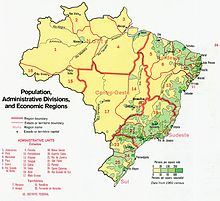
Back التركيبة السكانية في البرازيل Arabic Насельніцтва Бразіліі Byelorussian Население на Бразилия Bulgarian Demografia de Brasil CBK-ZAM Demografie Brasiliens German ބުރެޒިލްގެ ޑެމޮގްރަފީ DV Demografio de Brazilo Esperanto Demografía de Brasil Spanish مردم برزیل Persian Brasilian väestö Finnish
| Demographics of Brazil | |
|---|---|
 Population pyramid of Brazil in 2022 | |
| Population | |
| Density | |
| Growth rate | |
| Birth rate | |
| Death rate | |
| Life expectancy | |
| • male | |
| • female | |
| Fertility rate | |
| Infant mortality rate | |
| Net migration rate | |
| Age structure | |
| 0–14 years | |
| 15–64 years | |
| 65 and over | |
| Sex ratio | |
| Total | 0.97 male(s)/female (2023 est.)[2] |
| At birth | 1.05 male(s)/female |
| Under 15 | 1.04 male(s)/female |
| 15–64 years | 0.98 male(s)/female |
| 65 and over | 0.75 male(s)/female |
| Nationality | |
| Nationality | Brazilian |
| Major ethnic | |
| Minor ethnic | |
| Language | |
| Official | Portuguese |
| Spoken | Languages of Brazil |
Brazil had an official resident population of 203 million in 2022, according to IBGE.[4] Brazil is the seventh most populous country in the world and the second most populous in the Americas and Western Hemisphere.
Brazilians are mainly concentrated in the eastern part of the country, which comprises the Southeast, South, and Northeast. But it also has a significant presence in large cities in the Center-West and North.[5] According to the 2022 census, Brazil had 88,252,121 White people, 92,083,286 Mixed people, 20,656,458 Black people, 850,132 Asian people, and 1,227,640 Indigenous people.[1]


- ^ a b "Panorama". Censo 2022 (in Brazilian Portuguese). IBGE. Retrieved 11 February 2024.
- ^ "Brazil", The World Factbook, Central Intelligence Agency, 13 March 2024, retrieved 27 March 2024
- ^ a b c d e "Censo 2022". G1 (in Brazilian Portuguese). 22 December 2023. Retrieved 25 December 2023.
- ^ População do Brasil cresce 6,5 % e chega a 203,1 milhões, IBGE, 28 June 2023.
- ^ "Características da população e dos domicílios Resultados do universo" (PDF). Censo Demográfico 2020. IBGE. 8 November 2021. Archived from the original (PDF) on 25 May 2013. Retrieved 12 July 2014.